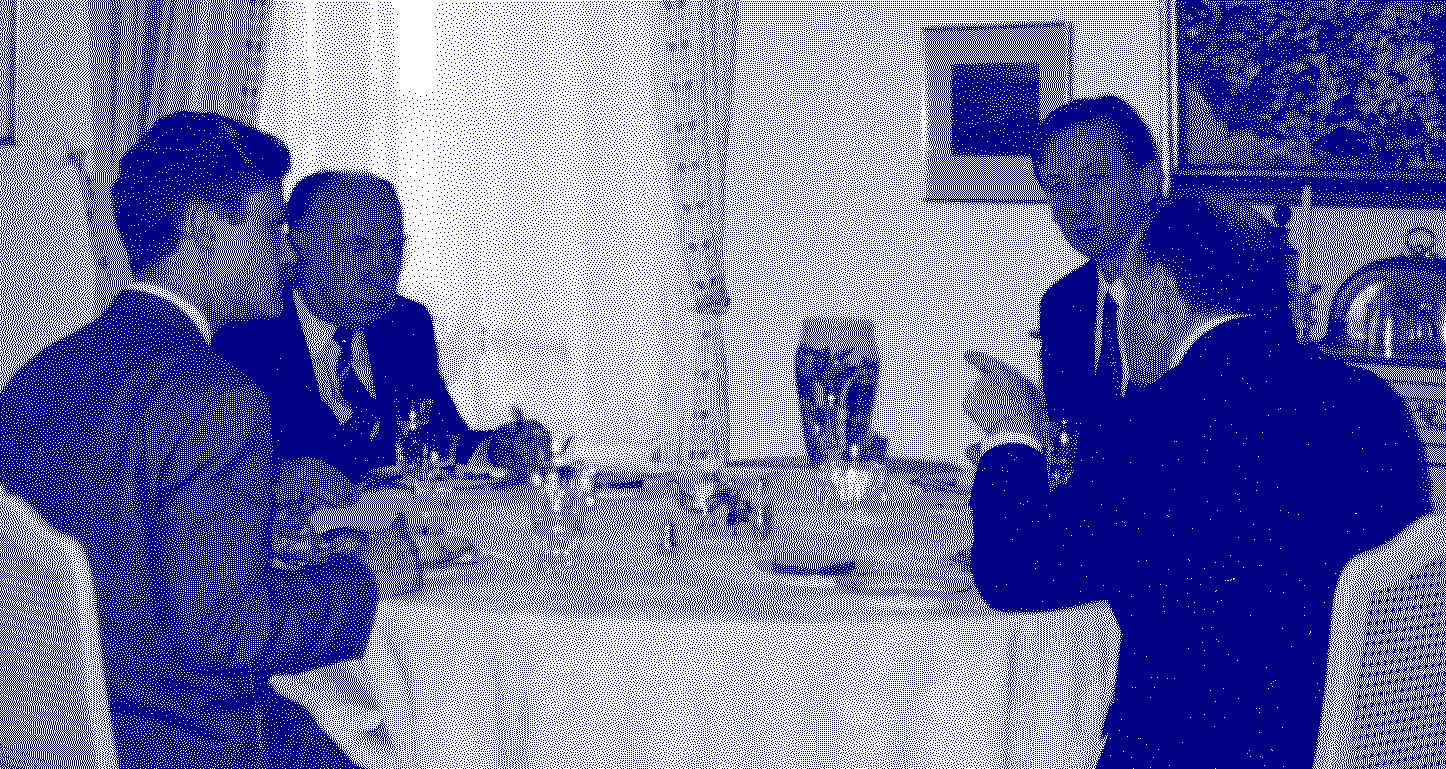


Ólafur Egilsson, Iceland's first ambassador to Russia and former Protocol Director at the Ministry of Foreign Affairs, is a master of connection. With a career shaped by diplomatic dinners and high-stakes seating plans, he offers fascinating insights into the subtle art of bringing people together.
Scroll to learn more
Q
Could you start by telling me a bit about your work at the Ministry of Foreign Affairs?
A
I was the protocol director there for several years, which involved organizing dinner parties among other things. At the embassy, I have of course also experienced how dinner parties can be useful for bringing people together and to pave the way for cooperation. Such functions can strengthen connections between individuals who may later have more substantial matters to discuss and can then do so after having gotten to know each other a bit. Dinner can then serve as an ice breaker and make it easier for them to have further interactions.
Q
What exactly does protocol direction involve?
A
Organising dinner parties for example. What has proven very important in such organisation is arranging seating for guests — both choosing to seat together people who you think will benefit from or enjoy meeting each other, and also to place those near each other who you think have similar interests. You should at least ensure that there is no animosity between those who you seat together, so that they don't feel uncomfortable close to each other.
Q
Having your experience of protocol direction, have you ever attended dinner and thought: “this could have been organised better?”
A
Yes, I can share an instance from a banquet for heads of state at Hotel Saga in Reykjavík. The Secretary of State and I were standing in the foyer where a seating chart had been displayed. As one guest arrived, he greeted my colleague, who handed him his seating card and explained where he would be sitting and next to whom. The man suddenly straightened up, swung his hand in a way that grazed my colleague's face, and declared, “I will not sit next to her,” referring to the woman he had been seated beside.
Of course, by that point, nothing could be changed, but the Secretary was understandably startled. I don't recall all the details, but we had no indication that there was any prior conflict between these individuals when the seating was arranged. It was the sort of background information that would have been impossible to anticipate.
Q
Arranging a successful dinner seems quite challenging. Are there many factors to consider?
A
It certainly can be! I remember a time at the President's Office when someone else had initially arranged the seating. When I was asked to review and finalize it, I noticed an issue: women of nearly equal rank were seated together, but the arrangement subtly implied that one was ranked higher than the other. I immediately realized this could cause upset.
Even though the seating cards had already been printed, I made the decision to have them completely reprinted to resolve this seemingly small issue. It might sound trivial, but in the world of protocol, such details matter greatly. These events are designed for people to enjoy themselves, and something as minor as seating arrangements can have a big impact.
Another example comes to mind from a dinner in Copenhagen, where one of the guests was a doctor. During the evening, he noticed that another guest seemed unwell. Concerned, they agreed to meet later in Reykjavík for further evaluation. It was during this follow-up that the doctor diagnosed the early stages of Parkinson's disease. That chance encounter at the dinner ultimately led to a vital medical connection, likely changing the course of the guest's treatment and care.
I also recall a dinner in London where the embassy was working on resolving unpaid debts owed to Icelandic creditors in Nigeria. I heard about a highly respected Nigerian man living in London, admired for his position in their tribal hierarchy, and invited him to the dinner. His presence had a remarkable impact. Those we were negotiating with showed great respect for him, and his advocacy on our behalf significantly smoothed the negotiations that followed. He was seated in a place of special honor due to his high standing and the esteem of his tribe. The other Nigerian man, who had been difficult to deal with in this matter, suddenly changed his tone entirely—he became very compliant and showed great deference.
Q
Arranging a successful dinner seems quite challenging. Are there many factors to consider?
A
In the biography of Talleyrand, who was, among other things, Napoleon's foreign minister, there's a story about his last official speech. It was a eulogy for a man who had also served as France's foreign minister. In this speech, Talleyrand described the qualities a foreign minister should possess, many of which are desirable traits for others as well.
He spoke, for instance, about conversations, and I'd like to read this to you in English from the book: “His conversations”—and here he's describing the ideal foreign minister—“His conversation should be simple, varied, unexpected, always natural, and sometimes naive.” I see here that I've bookmarked the passage.
Regarding the idea of being unexpected, I think I have a good example. It was at a dinner in Belgium hosted by François de Rose, France's permanent representative to NATO. He was highly esteemed and had been a member of France's nuclear council. I once read an article in a renowned magazine where Henry Kissinger even quoted him.
At this particular dinner, after we'd finished eating, two or three of us were standing near the piano with cups of coffee and glasses of cognac. De Rose joined us and asked, “Have you ever considered that if we placed a mirror 1,000 light-years away in space, we would now be seeing the birth of the Saviour?” [laughs]
It's an amusing thought—2,000 years after the approximate birth of Jesus. But I found this to be a good example of something entirely unexpected, something that would never have occurred to most people except for someone like him. In my view, this is very much in the spirit of what Talleyrand advocated—surprising people with ideas or perspectives that catch them off guard.
Q
Do you think that the art of conversation is of more importance in the context of the dinner table than in other settings?
A
It does play an incredibly important role, especially in relation to what you mentioned about dinner parties as cultural phenomena and symbols of social dynamics, customs, and human connections. These gatherings are, of course, unique opportunities for people to meet—people from diverse backgrounds coming together to exchange ideas about their daily pursuits. To make these occasions enjoyable, they need to follow the principles Talleyrand spoke about: they should be varied and often include something unexpected. For instance, I still remember that anecdote from 1973, which reflects this idea perfectly.
The main thing is that people should truly enjoy themselves at such gatherings. I also think about the arrangement of dinner parties and the role they play in bringing people closer, providing them with stimulating content to reflect on. This reminds me of Vilhjálmur Stefánsson, the Arctic explorer, who was one of the most renowned figures of his time for his research on the northern regions. There's even an island in northern Canada named Stefansson Island, as he spent much of his life in Canada.
His wife once shared that he greatly enjoyed hosting gatherings but insisted on keeping them small enough so that there could always be a single, unified conversation at the table that everyone could participate in.
Q
Do you notice any significant differences in dining etiquette now compared to around 1970?
A
It's hard for me to say definitively, as most of the people I interact with are close to my age, not from the younger generations. However, it is very important, especially when attending a gathering in another country, to be familiar with key table manners. Missteps in etiquette can sometimes affect how others perceive you, as people may form impressions based on how you conduct yourself at the table.
Q
Have you ever encountered a lack of manners that made you think, "This person isn't particularly refined"?
A
I do recall an instance from before I joined the foreign service. I accompanied a group on an educational trip to NATO, and the NATO spokesperson responsible for hosting such groups invited us to lunch. During the meal, an apprentice sitting near him reached across the host's plate to grab something. Naturally, the host commented on it in a good-natured manner but also expressed surprise. Unfortunately, he shared a rather negative impression of the young man in this regard.
Q
Have you ever encountered a lack of manners that made you think, "This person isn't particularly refined"?
A
I do recall an instance from before I joined the foreign service. I accompanied a group on an educational trip to NATO, and the NATO spokesperson responsible for hosting such groups invited us to lunch. During the meal, an apprentice sitting near him reached across the host's plate to grab something. Naturally, the host commented on it in a good-natured manner but also expressed surprise. Unfortunately, he shared a rather negative impression of the young man in this regard.
Q
There seems to be quite a science behind all these customs. Can you share some interesting etiquette traditions from other cultures?
A
Absolutely, and these customs vary widely between countries. It's always helpful to be familiar with them. For example, Queen Elizabeth had a particular approach to conversation during meals. Rather than alternating between the guests on her left and right throughout the meal, she would spend the first half speaking to the guest on her left and the second half speaking to the guest on her right.
I once attended a luncheon where I was seated between her and Princess Margaret, her sister. The Queen hosted this luncheon in honor of Vigdís Finnbogadóttir, and at the time, I was Iceland's ambassador to London. The presidential secretary, Kornelíus Sigfússon, was seated to her left, and I was seated to her right—a position that, according to international protocol, holds greater honor. During the meal, the Queen spoke with the secretary during the first half and then turned her attention to me for the second half. Understanding these customs is important—it wasn't a slight against me, just her way of doing things.
Protocol rules, such as seating arrangements, are especially significant in formal settings. For instance, the seat to the host's right is the place of highest honor, followed by the seat to their left, and then outward from the host in descending order. These arrangements often reflect specific hierarchies. In less formal gatherings, however, you can often create your own seating rules. When there's no need to follow strict hierarchies, the key is to know your guests well and thoughtfully arrange the seating so that people who would enjoy each other's company are placed together.
Q
Is there anything you would like to add?
A
One unexpected moment comes to mind from a dinner in Brussels, hosted by the Danish Deputy Permanent Representative to NATO. The conversation turned to a story about a world-famous actress—I believe it was someone very well-known—who had mentioned that she never slept in pajamas, only in Chanel No. 5. Then the hostess, a beautiful woman sitting near me, said, “Oh, I do the same” [laughs]. That was completely unexpected as well!
Back to Menu Hungry for more?